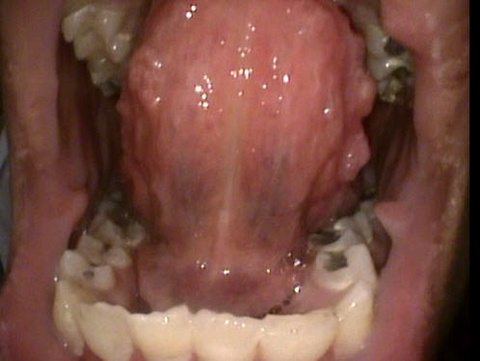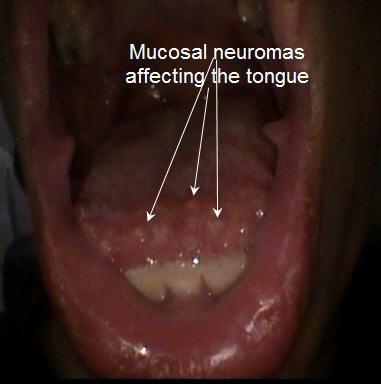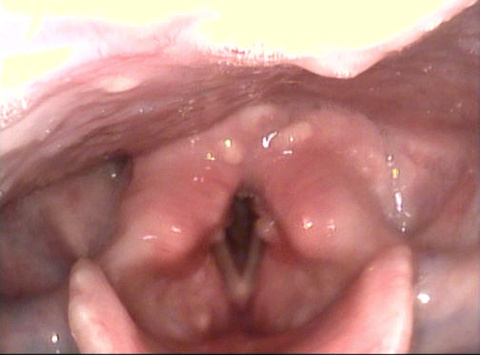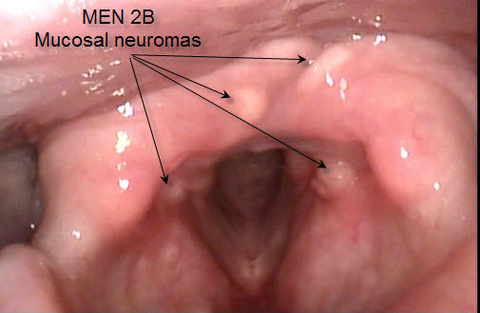Return to: Medullary Thyroid Carcinoma
See also: Neural Crest Cell Tumors (PNT = peripheral neuroblastic tumors)
Overview
- Background
- MEN IIB is caused by mutations in the RET proto-oncogene, generally in the TK1 domain.
- Classic clinical symptoms include
- Medullary thyroid cancer in infancy or childhood
- Pheochromocytoma
- Marfanoid habitus (Tall, thin, increased joint laxity)
- Mucosal neuromas (tongue, eyelids, GI tract) - multiple mucosal neuromas are a dominant feature of MEN 2B
- Early recognition is key to preventing metastatic medullary thyroid cancer.
- Workup
- Baseline serum calcitonin, calcium, CEA
- Screening for pheochromocytoma
- Thyroid, central and lateral neck ultrasound
- CT chest or PET imaging for large tumors (>1cm), evidence of nodal disease or serum calcitonin >400pg/ml
- Genetic testing, genetic counseling
- Management: Multidisciplinary team approach with Otolaryngology, Endocrinology, Gastroenterology, Oncology, Genetics, Social Work
- Thyroid:
- Total thyroidectomy with level VI (central neck) lymph node dissection before age 1 is recommended for all known MENII patients (see Thyroidectomy and Thyroid Lobectomy)
- If tumor is >0.5cm at presentation, consider extensive neck dissection (levels II-V)
- For large tumors, positive surgical margin, ETE (extra-thyroidal extension), may benefit from external beam radiation
- Tyrosine kinase inhibitors: vandetanib or cabozantinib
- Parathyroids:
- Hyperparathyroid is common and can manifest with elevated serum calcium, bone pain, kidney stones, nausea, and depression
- Management is removal of adenoma or 3.5 parathyroid glands (see Parathyroidectomy)
- Monitoring:
- Patients should be followed regularly after thyroidectomy to monitor for recurrence
- 2-3 month post-op calcitonin and CEA levels. If >150pg/ml, image neck, chest and abdomen for persistent/recurrent disease
- Annual calcitonin, CEA and calcium levels
- Regular blood pressure checks
- Thyroid:
Images




References
Pujol RM, Matias-Guiu X, Miralles J, Colomer A, de Moragas JM (August 1997). "Multiple idiopathic mucosal neuromas: a minor form of multiple endocrine neoplasia type 2B or a new entity?". J. Am. Acad. Dermatol. 37 (2 Pt 2): 349–52.
Ferreira CV, Siqueira DR, Ceolin L, Maia AL. May 2012. Advanced medullary thyroid cancer: pathophysiology and management Cancer Manag Res. 2013 May 8;5:57-66. doi: 10.2147/CMAR.S33105. Print 2013.
Shankar RK, Rutter MJ, Chernausek SD, Samuels PJ, Mo JQ, Rutter MM. Medullary thyroid cancer in a 9-week-old infant with familial MEN 2B: Implications for timing of prophylactic thyroidectomy. Int J Pediatr Endocrinol. 2012 Sep 19;2012(1):25. doi: 10.1186/1687-9856-2012-25.
NCCN National comprehensive Cancer Network Guidelines, Thyroid Carcinoma version 2.2013
Mathiesen JS, Effraimidis G, Rossing M, Rasmussen ÅK, Hoejberg L, Bastholt L, Godballe C, Oturai P, Feldt-Rasmussen U. Multiple endocrine neoplasia type 2: A review. Semin Cancer Biol. 2022 Feb;79:163-179. doi: 10.1016/j.semcancer.2021.03.035. Epub 2021 Apr 1. PMID: 33812987.